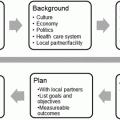Aspects
Detail
Reference
Definition
The science and art of preventing disease, prolonging life, and promoting health through the organized efforts and informed choices of society, organizations, public and private, communities, and individuals
[1]
• Organized community efforts aimed at the prevention of disease and promotion of health
[58]
• What we, as a society, do collectively to assure the conditions in which people can be healthy
Public health involves the application of many different disciplines including epidemiology, biostatistics, anthropology, medicine, sociology, and public policy, to name a few
[59]
Public health is defined as health promotion by population-related measures. This is in contrast to the aims of medicine with its diagnostics and therapy which focus on the individual patient’s health
[60]
The approach to medicine that is concerned with the health of the community as a whole
[62]
Science and art of preventing disease, prolonging life, and promoting health through organized community efforts
[63]
An effort organized by society to protect, promote, and restore the people’s health. It is the combination of sciences, skills, and beliefs that is directed to the maintenance and improvement of health through collective or social actions. The programs, services, and institutions of public health emphasize the prevention of disease and the health needs of the population as a whole. Additional goals include the reduction of the amount of disease, premature death, disability, and discomfort in the population
[65]
Mission and scope
Fulfilling society’s interest in assuring conditions in which people can be healthy
[58]
Public health is one of the essential institutions of society. It exists to promote, protect, preserve, and restore the good health of all the people, and it achieves these ends largely through collective action
[61]
Public health emphasizes health promotion, the prevention, and early detection of disease, disability, and premature death. Many scientific disciplines, technologies, and practical skills are involved in public health, which can be viewed as a social institution, a collective discipline (one that focuses a large group of discrete disciplines on public health), and a practice
The programs, services, organizations, and institutions devoted to public health are concerned with the health needs of the entire populations. Professionals engaged in the field regard it as an organized effort directed at improving the health of populations by assuring the conditions in which people can be healthy. It thus differs from the healing arts such as medicine, dentistry, nursing, and pharmacy that aim their services at the health of individuals
It is concerned with threats to the overall health of a community based on population health analysis. The population in question can be as small as a handful of people or as large as all the inhabitants of several continents
[64]
While public health is comprised of many professional disciplines such as medicine, dentistry, nursing, optometry, nutrition, social work, environmental sciences, health education, health services administration, and the behavioral sciences, its activities focus on entire populations rather than on individual patients. Doctors usually treat individual patients one-on-one for a specific disease or injury. Public health professionals monitor and diagnose the health concerns of the entire communities and promote healthy practices and behaviors to assure our populations stay healthy
[62]
Core functions
• The assessment and monitoring of the health of communities and populations at risk to identify health problems and priorities
[62]
• The formulation of public policies designed to solve identified local and national health problems and priorities
• To assure that all populations have access to appropriate and cost-effective care, including health promotion and disease prevention services, and evaluation of the effectiveness of that care
Common relationship with radiology
The component parts of public health include a wide array of intellectual disciplines, professions, trades, and practical skills: vital statistics, demography, epidemiology, and biostatistics; basic medical sciences such as microbiology, physiology, pharmacology, and toxicology; physical sciences such as physics and chemistry; engineering; social and behavioral sciences; and clinical sciences such as those that deal with communicable diseases, cancer, and heart disease. Mature professions such as medicine, nursing, dentistry, and law, as well as newly emerged professions such as psychology, nutrition, and dietetics are all engaged in public health
[61]
Public health involves the application of many different disciplines including epidemiology, biostatistics, anthropology, medicine, sociology, and public policy, to name a few
[59]
Truly at the forefront of digital health information, the specialty of radiology has been identified as a key player in the development of new public health strategies (Table 14.1). For example, in terms of informatics, the “backbone” of medical imaging and digital health information, Mollura and colleagues described a link between radiology and public health, ultimately concluding that in this context radiology can be considered an “information supplier” [2]. This notion was further expanded in by Hillman, who advocated a paradigm shift in terms of the concept of radiology as an independent entity to one that builds a formal information network interconnected with a broad range of public health entities [3]. This capability would allow imaging studies and reports stored digitally to serve as readily accessible resources of population health data that can play “a critical role in surveillance, prevention, and diagnosis of disease” [4]. Effective networks and sophisticated population-based surveillance can be based on this information, and will ultimately play an integral role in how public health is practiced.
Public Health Radiology: Role of Radiology in Public Health Programs
Public health programs already in place use medical imaging as an integral component; the Stop TB Partnership [5] and the surveillance of H1N1 influenza pandemic [6] are two such examples. In these and other programs, public health radiology is concerned with applying diagnostic and therapeutic radiology technology as a driver of disease surveillance and prevention at the population level rather than diagnosis and treatment of individual patients. While clinical radiologists’ interests are the diagnosis and treatment of disease, public health radiology imaging efforts focus on population-level diseases that are largely related to screening.
Mammography for Breast Cancer Screening
Breast cancer was diagnosed in almost 1.4 million women in 2008, and approximately 460,000 deaths were recorded [7, 8]. Although developed countries found higher incidence than less developed ones, 5-year relative survival estimates were much more (12 % in Africa to 90 % in the United States, Australia, and Canada) [8]. One potential explanation of this inequity is the different performances of healthcare systems in terms of preventive measures.
Early detection by mammography screening was shown to reduce risk of breast cancer death [9]; mortality in the screened group was 35 % lower than in the unscreened group [10]. Improvements in survival in more developed parts of the world have been attributed to the introduction of population-based screening using mammography [8], the systematic use of adjuvant therapies [8], and multidisciplinary medical care [11]. Based on the data from population-based mammography screening in Australia, Protani et al. was able to identify modifiable lifestyle factors associated with breast cancer, which is very useful for further development of public health interventions [12].
Nonetheless, like other tests, mammography screening does have some negative side effects such as false-positive results, which can lead to anxiety and discomfort [13]. Zahl and Maehien analyzed 14-year Norwegian data and reported that mammography screening resulted in “overdiagnosis” and “overtreatment” [14].
Chest X-Ray for Tuberculosis Screening
Tuberculosis (TB) is the leading cause of death worldwide, only second to HIV/acquired immune-deficiency syndrome (AIDS) [15]. This disease is prevalent in the developing world; approximately 9.27 million people developed TB (139/100,000 population) and 1.77 million died in 2007 [16]. Among the incident cases, 14.8 % were HIV positive. Approximately 10 % of all new TB cases in adults were estimated to be attributable to HIV infection, and TB was the cause of about 10 % of all adult AIDS deaths [17]. Not only does HIV increase the risk of rapid TB progression, but it can also reactivate latent Mycobacterium tuberculosis infection [18, 19].
Targets for reductions in global TB burden have been set within the context of the Millennium Development Goals (MDGs) and by the Stop TB Partnership that the incidence should be falling by 2015, that prevalence and mortality should be halved by 2015 relative to 1990 levels, and that TB should be eliminated (less than 1 case per million population per year) by 2050. Unfortunately, as surveillance systems in most countries are not comprehensive enough, infected patients either go undiagnosed (i.e., lack of healthcare access) or get treated but not notified (i.e., care by private practitioner).
Chest X-ray (CXR) has been an important tool for the diagnosis, prediction, and management of tuberculosis (TB) [5]. For instance, the presence of a cavity on a CXR taken during the first 2 months of treatment is associated with threefold higher risk of TB relapse [20], and the patients with cavity and positive sputum therefore require longer therapy [21]. However, limitations on the wider use of CXR, such as nonavailability at health facilities in the prevalent areas and the difficulty of interpreting results, have been of great concern [22]. While better diagnostics for TB is not available as of yet [23], traditional tools like CXR are still essential.
Active case finding by using mass miniature radiography (MMR) has been anticipated to detect approximately 90 % of prevalent tuberculosis cases [24, 25] and was suggested as a cost-effective strategy in low- and middle-income countries with high prevalence [15]. With this approach, the entire population would be screened every 7 years by using MMR, followed by sputum examination for those with suspicious lesions. Murray and Salomon suggested that active case finding, along with the WHO DOTS strategy, could reduce TB mortality by as much as one-quarter to one-third over several decades [26].
Nonetheless, specificity of the CXR has been questioned, especially among patients with the AIDS, who may present with various respiratory illnesses. In the past, experts missed approximately one-quarter of tuberculosis cases in a series of films [27]. However, the reliability of radiographic interpretation has greatly improved [20], especially with digital advancement. While analogue CXR uses high X-ray dose, tends to produce poor quality images, requires experienced staff to interpret, needs labor-intensive image archival, and causes environmental damage from chemical waste, digital technology has the potential to solve most of these problems at lower costs, higher speed [22], and better positive predictive value [28].
The Computer-Aided Detection of Tuberculosis (CAD4TB) project is one of the most promising developments of feasible digital technology to improve CXR interpretation in resource-limited settings [29, 30]. This is a very good example of how concerns about varying reliability of interpretation of TB CXRs can result in the development of radiological technology that is not only innovative but also very useful for mass population screening for TB [29].
CT Colonography for Colorectal Cancer Screening
With more than 1.2 million new cases and 600,000 deaths, colorectal cancer is the second and third most commonly diagnosed cancer in females and males, respectively [7]. The significant higher incidence and mortality in developed countries than in the developing ones have suggested the importance of dietary and environmental exposures [31, 32].
Endoscopic screening with flexible sigmoidoscopy or colonoscopy has been widely regarded as the standard for detection of colorectal tumors [33]. Although it offers some advantages including instant removal of adenomatous polyps—the precursor lesions of colorectal cancer—it does not comply with many of the criteria for a screening test as it is not simple, it is expensive, and it requires highly trained clinicians for its application [34]. In addition, a number of disadvantages such as the need for full bowel cleansing, aggressive nature of the procedure, and possible complications such as bleeding and perforation do exist.
Computed tomography (CT) colonography was introduced partly to overcome some of those limitations [35]. With insufficient evidence to assess the benefits and harms, CT colonography has not been recommended in the USA [33]. However, more supporting evidence has been released, and its use for mass population screening is promising. For instance, Johnson et al. acquired CT colonographic images of 2,600 asymptomatic adults and reported 90 % sensitivity for detecting a 10-mm lesion [36]. A population-based screening study in the Netherlands reported that both CT colonography and colonoscopy can be used, but participation in CT colonography is better [37]. CT colonography can also be used for evaluation of the colon after an incomplete conventional colonography [38]. This is a very good example of how a feasibility concern from the public health perspective plays relatively more of a role than the technical aspect of a medical intervention.
Chest X-Ray for Lung Cancer Screening
Lung cancer is one of the most commonly diagnosed cancers as well as the leading cause of cancer death in 2008 globally—13 % of the total cases and 18 % of the deaths [7]. Case fatality rate is as high as 90 % [39].
In 1987, the Japanese government introduced lung cancer screening using CXR and sputum cytology [40]. The matched case-control studies suggested that mass CXR screening for lung cancers contributed to a significant mortality reduction of about 40 % [41]; however, potential bias from self-selection of the studies limited the generalizability of the findings. In 1997, a population-based cohort of almost 6,000 heavy- or long-term smokers was invited to an annual CXR screening program and was followed for 13.5 years. The study found that screening participants who were diagnosed with lung cancer had more early-stage resectable disease and longer survival [42]. Recently, the effect of screening for lung cancer with CXR has been evaluated in the Prostate, Lung, Colorectal, and Ovarian (PLCO) Cancer Screening Trial, and the investigators found that annual screening with CXR does not reduce lung cancer mortality compared to usual care without screening [43]. Unfortunately, evidence on the risk and benefit of using low-dose CT, CXR, sputum cytology, or a combination of these tests for mass lung cancer screening has still been considered insufficient [44].
Stay updated, free articles. Join our Telegram channel

Full access? Get Clinical Tree






